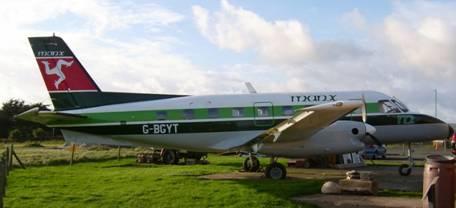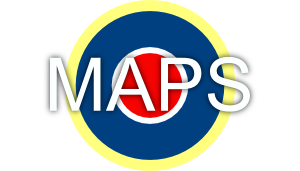Patrons:
Air Marshal Sir Ian Macfadyen
The Lieutenant Governor, His Excellency Lieutenant General Sir John Lorimer KCB DSO MBE
The Embraer Bandeirante

EMBRAER EMB-110P1 “BANDEIRANTE”, G-BGYT
Manufacturer’s number 110-234, built in 1979 by Embraer in Brazil.
Powered by Pratt & Whitney Canada PT6A-34 engines.
 The museum was given the stripped hulk of Embraer Bandeirante G-BGYT in mid-2006. It had been stripped of useable parts following an engine failure on take-off, followed by a successful emergency landing. The aircraft languished on stacks of pallets and was looking very derelict, not at all the sort of thing we want to have associated with the museum. The process of refurbishment began in September 2008 with the purchase of a pair of main undercarriage units, an aileron, propellers and nose cone. These were bought using part of a donation from a very generous supporter of the museum. The donation has in fact paid for the whole restoration process – parts, paint and everything and we must give sincere thanks to the donor as without their help the refurbishment would have put a severe strain on our resources.
The museum was given the stripped hulk of Embraer Bandeirante G-BGYT in mid-2006. It had been stripped of useable parts following an engine failure on take-off, followed by a successful emergency landing. The aircraft languished on stacks of pallets and was looking very derelict, not at all the sort of thing we want to have associated with the museum. The process of refurbishment began in September 2008 with the purchase of a pair of main undercarriage units, an aileron, propellers and nose cone. These were bought using part of a donation from a very generous supporter of the museum. The donation has in fact paid for the whole restoration process – parts, paint and everything and we must give sincere thanks to the donor as without their help the refurbishment would have put a severe strain on our resources.

Mock-up of the Manx Airlines paint scheme. No Photoshop here, just coloured pencils on a photo of the aircraft!
The most difficult question was what colour scheme to paint it in? Its own final blue and white Flykeen colour scheme was to say the least uninspiring. The decision was made that the earliest Manx Airlines scheme would look best even though, despite using a Bandeirante in its early years, Manx never painted the aircraft in their full scheme.
The first stage in the resurrection was the addition of a newly repainted nose cone which on its own made a significant improvement to the hitherto truncated appearance of the fuselage. This was soon followed by the installation of the undercarriage which gave the aircraft a much better stance. We didn’t have a nose undercarriage so one was skilfully built by Mike Corlett using a mainwheel and hub from a Cessna light aircraft attached to a hydraulic strut from a JCB digger. This might sound strange but once it was painted it looked very convincing.

The Manx Airlines colour scheme was measured up and marked onto the airframe. The actual colours used by Manx Airlines caused a few headaches. The underside is Light Aircraft Grey which is a British Standard colour as is the dark green which is Deep Brunswick Green. The light green seems to vary from one aircraft to another so I researched it in a bit more depth. In our archives are the original British Aerospace drawings for the Manx Airlines colour schemes of the ATP and the BAe146 jet. These give the paint manufacturer’s codes for the colours but unfortunately the manufacturer is no more. I then spoke to Captain Norman Brewitt who was involved in the original designs. Captain Brewitt couldn’t help with identifying the colours as he had simply used the coloured pencils that were on his desk at the time! I finally took a number of photographs of Manx Airlines aircraft to a local motor factor and picked a vehicle paint colour that was somewhere in the right area. You wouldn’t believe how many different shades of pale green there are but if anybody asks, this is THE correct one. Within a week of getting hold of the paint Phil Pain mentioned that he had a chip of original light green paint from a Manx Shorts 360. Hmm.

Painting started in July but despite my being available full-time since my retirement the work could only continue in fits and starts due to the dismal weather during the summer of 2009. Many of the few dry days were too windy for spraying, even a light wind would be channelled by the shape of the aircraft into a tearing gale, blowing the paint away as soon as it left the spraygun. Goodness knows how many sheets of newspaper were used for masking but I do know that I used about three quarters of a kilometre of masking tape (that’s over 800 yards in real measurement). All the painting was complete by the beginning of September and the final big job was the application of a coat of wax polish to protect the paint through the winter. This was done by an enthusiastic team of people from Continent 8 Technologies, a very successful international organisation at the cutting edge of internet technology based in Douglas, who were wanting to give something back to the community as a team-building exercise. This they did with commendable skill and a lot of laughs on two lovely sunny days. The polishing was so successful that the walkways on top of the wings are now like sheets of ice, as I later found to my discomfort when I found myself scrabbling desperately for grip whilst sliding on hands and knees towards the rear edge of the wing! This company has promised ongoing support for the museum and we have welcomed this offer with open arms.
After the paintwork the final touch which really gave the aeroplane an identity was the application of vinyl Manx Airlines logos.
Mike Corlett made a pair of replica propeller spinners in fibreglass and the propellers were mounted using a space frame in place of the missing engines. Surprisingly the holes for the bolts which fix the propellers onto the engines are exactly the same distance apart as those on a Ford Escort wheel hub so two hubs were modified to give rotating propellers.

During the refurbishment extensive corrosion proofing has been carried out so the Bandeirante should withstand the rigours of Ronaldsway’s harsh weather for some time to come. The finished aircraft has created a lot of interest with several people asking when Manx Airlines will be flying again.
